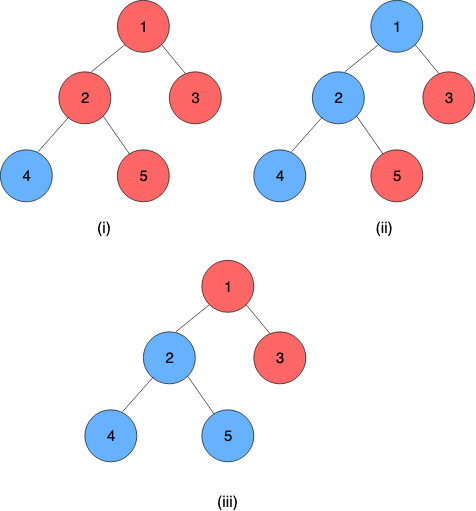CF1208H.Red Blue Tree
普及/提高-
通过率:0%
AC君温馨提醒
该题目为【codeforces】题库的题目,您提交的代码将被提交至codeforces进行远程评测,并由ACGO抓取测评结果后进行展示。由于远程测评的测评机由其他平台提供,我们无法保证该服务的稳定性,若提交后无反应,请等待一段时间后再进行重试。
题目描述
You are given a tree of n nodes. The tree is rooted at node 1 , which is not considered as a leaf regardless of its degree.
Each leaf of the tree has one of the two colors: red or blue. Leaf node v initially has color sv .
The color of each of the internal nodes (including the root) is determined as follows.
- Let b be the number of blue immediate children, and r be the number of red immediate children of a given vertex.
- Then the color of this vertex is blue if and only if b−r≥k , otherwise red.
Integer k is a parameter that is same for all the nodes.
You need to handle the following types of queries:
- 1 v: print the color of node v ;
- 2 v c: change the color of leaf v to c ( c=0 means red, c=1 means blue);
- 3 h: update the current value of k to h .
输入格式
The first line of the input consists of two integers n and k ( 2≤n≤105 , −n≤k≤n ) — the number of nodes and the initial parameter k .
Each of the next n−1 lines contains two integers u and v ( 1≤u,v≤n ), denoting that there is an edge between vertices u and v .
The next line consists of n space separated integers — the initial array s ( −1≤si≤1 ). si=0 means that the color of node i is red. si=1 means that the color of node i is blue. si=−1 means that the node i is not a leaf.
The next line contains an integer q ( 1≤q≤105 ), the number of queries.
q lines follow, each containing a query in one of the following queries:
- 1 v ( 1≤v≤n ): print the color of node v ;
- 2 v c ( 1≤v≤n , c=0 or c=1 ): change the color of leaf v to c ( c=0 means red, c=1 means blue). It is guaranteed that v is a leaf;
- 3 h ( −n≤h≤n ): update the current value of k to h .
输出格式
For each query of the first type, print 0 if the color of vertex v is red, and 1 otherwise.
输入输出样例
输入#1
5 2 1 2 1 3 2 4 2 5 -1 -1 0 1 0 9 1 1 1 2 3 -2 1 1 1 2 3 1 2 5 1 1 1 1 2
输出#1
0 0 1 1 0 1
说明/提示
Figures:(i) The initial tree
(ii) The tree after the 3rd query
(iii) The tree after the 7th query
